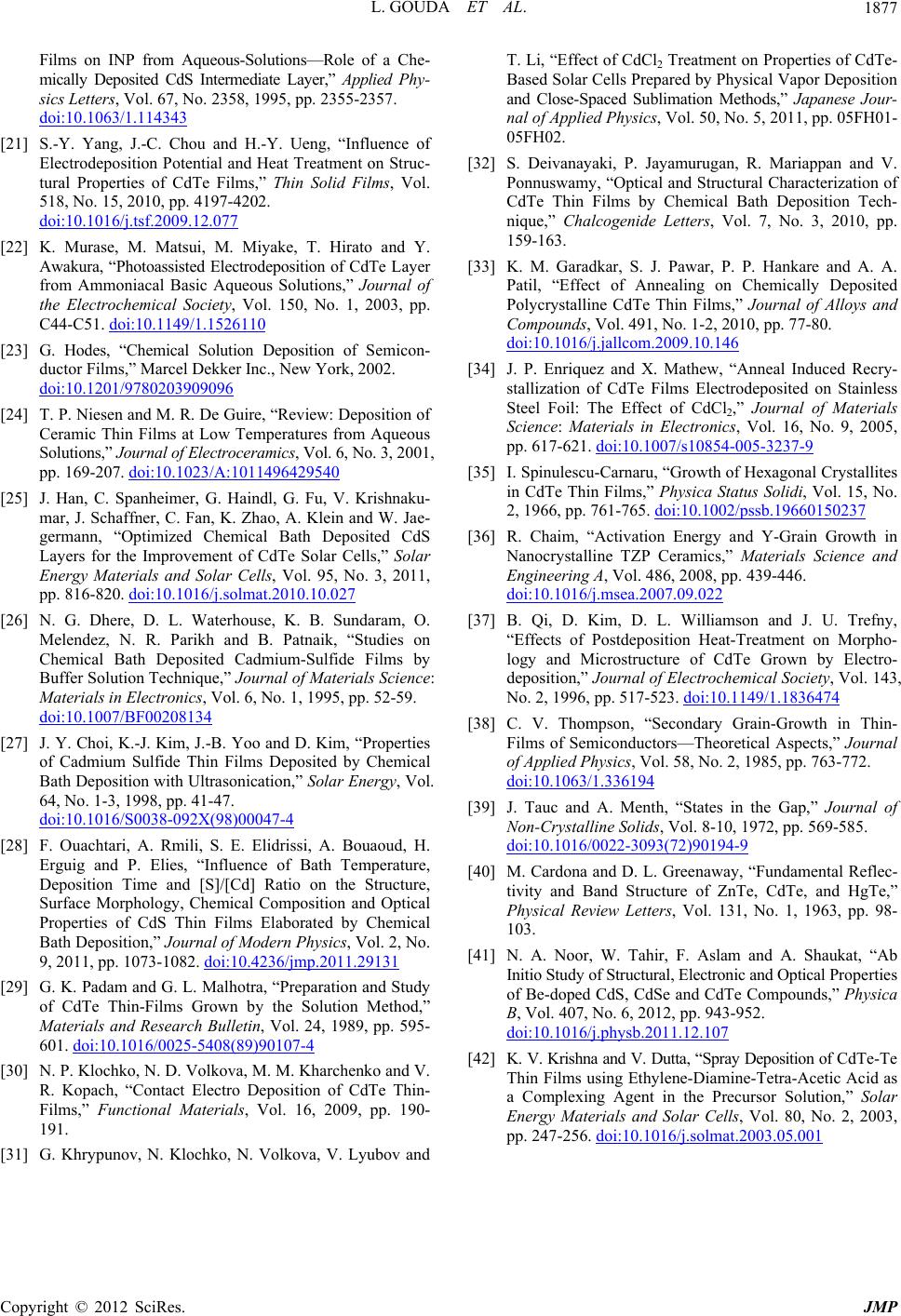
L. GOUDA ET AL.
Copyright © 2012 SciRes. JMP
1877
Films on INP from Aqueous-Solutions—Role of a Che-
mically Deposited CdS Intermediate Layer,” Applied Phy-
sics Letters, Vol. 67, No. 2358, 1995, pp. 2355-2357.
doi:10.1063/1.114343
[21] S.-Y. Yang, J.-C. Chou and H.-Y. Ueng, “Influence of
Electrodeposition Potential and Heat Treatment on Struc-
tural Properties of CdTe Films,” Thin Solid Films, Vol.
518, No. 15, 2010, pp. 4197-4202.
doi:10.1016/j.tsf.2009.12.077
[22] K. Murase, M. Matsui, M. Miyake, T. Hirato and Y.
Awakura, “Photoassisted Electrodeposition of CdTe Layer
from Ammoniacal Basic Aqueous Solutions,” Journal of
the Electrochemical Society, Vol. 150, No. 1, 2003, pp.
C44-C51. doi:10.1149/1.1526110
[23] G. Hodes, “Chemical Solution Deposition of Semicon-
ductor Films,” Marcel Dekker Inc., New York, 2002.
doi:10.1201/9780203909096
[24] T. P. Niesen and M. R. De Guire, “Review: Deposition of
Ceramic Thin Films at Low Temperatures from Aqueous
Solutions,” Journal of Electroceramics, Vol. 6, No. 3, 2001,
pp. 169-207. doi:10.1023/A:1011496429540
[25] J. Han, C. Spanheimer, G. Haindl, G. Fu, V. Krishnaku-
mar, J. Schaffner, C. Fan, K. Zhao, A. Klein and W. Jae-
germann, “Optimized Chemical Bath Deposited CdS
Layers for the Improvement of CdTe Solar Cells,” Solar
Energy Materials and Solar Cells, Vol. 95, No. 3, 2011,
pp. 816-820. doi:10.1016/j.solmat.2010.10.027
[26] N. G. Dhere, D. L. Waterhouse, K. B. Sundaram, O.
Melendez, N. R. Parikh and B. Patnaik, “Studies on
Chemical Bath Deposited Cadmium-Sulfide Films by
Buffer Solution Technique,” Journal of Materials Science:
Materials in Electronics, Vol. 6, No. 1, 1995, pp. 52-59.
doi:10.1007/BF00208134
[27] J. Y. Choi, K.-J. Kim, J.-B. Yoo and D. Kim, “Properties
of Cadmium Sulfide Thin Films Deposited by Chemical
Bath Deposition with Ultrasonication,” Solar Energy, Vol.
64, No. 1-3, 1998, pp. 41-47.
doi:10.1016/S0038-092X(98)00047-4
[28] F. Ouachtari, A. Rmili, S. E. Elidrissi, A. Bouaoud, H.
Erguig and P. Elies, “Influence of Bath Temperature,
Deposition Time and [S]/[Cd] Ratio on the Structure,
Surface Morphology, Chemical Composition and Optical
Properties of CdS Thin Films Elaborated by Chemical
Bath Deposition,” Journal of Modern Physics, Vol. 2, No.
9, 2011, pp. 1073-1082. doi:10.4236/jmp.2011.29131
[29] G. K. Padam and G. L. Malhotra, “Preparation and Study
of CdTe Thin-Films Grown by the Solution Method,”
Materials and Research Bulletin, Vol. 24, 1989, pp. 595-
601. doi:10.1016/0025-5408(89)90107-4
[30] N. P. Klochko, N. D. Volkova, M. M. Kharchenko and V.
R. Kopach, “Contact Electro Deposition of CdTe Thin-
Films,” Functional Materials, Vol. 16, 2009, pp. 190-
191.
[31] G. Khrypunov, N. Klochko, N. Volkova, V. Lyubov and
T. Li, “Effect of CdCl2 Treatment on Properties of CdTe-
Based Solar Cells Prepared by Physical Vapor Deposition
and Close-Spaced Sublimation Methods,” Japanese Jour-
nal of Applied Physics, Vol. 50, No. 5, 2011, pp. 05FH01-
05FH02.
[32] S. Deivanayaki, P. Jayamurugan, R. Mariappan and V.
Ponnuswamy, “Optical and Structural Characterization of
CdTe Thin Films by Chemical Bath Deposition Tech-
nique,” Chalcogenide Letters, Vol. 7, No. 3, 2010, pp.
159-163.
[33] K. M. Garadkar, S. J. Pawar, P. P. Hankare and A. A.
Patil, “Effect of Annealing on Chemically Deposited
Polycrystalline CdTe Thin Films,” Journal of Alloys and
Compounds, Vol. 491, No. 1-2, 2010, pp. 77-80.
doi:10.1016/j.jallcom.2009.10.146
[34] J. P. Enriquez and X. Mathew, “Anneal Induced Recry-
stallization of CdTe Films Electrodeposited on Stainless
Steel Foil: The Effect of CdCl2,” Journal of Materials
Science: Materials in Electronics, Vol. 16, No. 9, 2005,
pp. 617-621. doi:10.1007/s10854-005-3237-9
[35] I. Spinulescu-Carnaru, “Growth of Hexagonal Crystallites
in CdTe Thin Films,” Physica Status Solidi, Vol. 15, No.
2, 1966, pp. 761-765. doi:10.1002/pssb.19660150237
[36] R. Chaim, “Activation Energy and Y-Grain Growth in
Nanocrystalline TZP Ceramics,” Materials Science and
Engineering A, Vol. 486, 2008, pp. 439-446.
doi:10.1016/j.msea.2007.09.022
[37] B. Qi, D. Kim, D. L. Williamson and J. U. Trefny,
“Effects of Postdeposition Heat-Treatment on Morpho-
logy and Microstructure of CdTe Grown by Electro-
deposition,” Journal of Electrochemical Society, Vol. 143,
No. 2, 1996, pp. 517-523. doi:10.1149/1.1836474
[38] C. V. Thompson, “Secondary Grain-Growth in Thin-
Films of Semiconductors—Theoretical Aspects,” Journal
of Applied Physics, Vol. 58, No. 2, 1985, pp. 763-772.
doi:10.1063/1.336194
[39] J. Tauc and A. Menth, “States in the Gap,” Journal of
Non-Crystalline Solids, Vol. 8-10, 1972, pp. 569-585.
doi:10.1016/0022-3093(72)90194-9
[40] M. Cardona and D. L. Greenaway, “Fundamental Reflec-
tivity and Band Structure of ZnTe, CdTe, and HgTe,”
Physical Review Letters, Vol. 131, No. 1, 1963, pp. 98-
103.
[41] N. A. Noor, W. Tahir, F. Aslam and A. Shaukat, “Ab
Initio Study of Structural, Electronic and Optical Properties
of Be-doped CdS, CdSe and CdTe Compounds,” Physica
B, Vol. 407, No. 6, 2012, pp. 943-952.
doi:10.1016/j.physb.2011.12.107
[42] K. V. Krishna and V. Dutta, “Spray Deposition of CdTe-Te
Thin Films using Ethylene-Diamine-Tetra-Acetic Acid as
a Complexing Agent in the Precursor Solution,” Solar
Energy Materials and Solar Cells, Vol. 80, No. 2, 2003,
pp. 247-256. doi:10.1016/j.solmat.2003.05.001